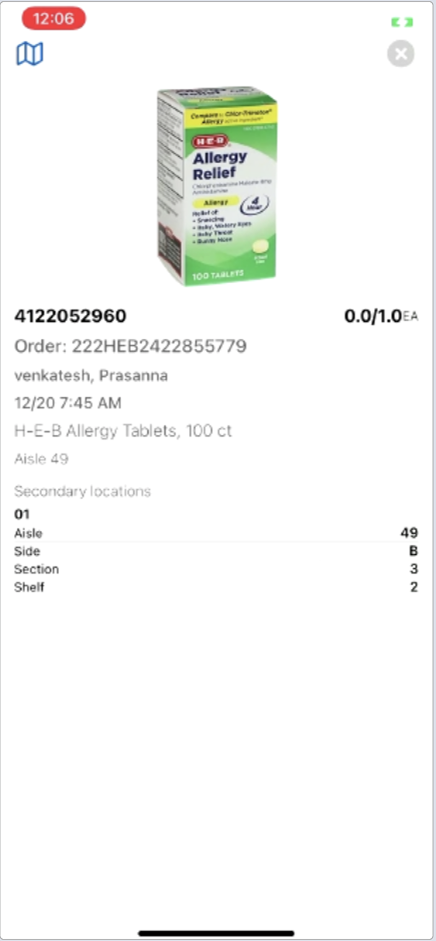Breaking bag
Breaking the $5B threshold at the #1 grocery retailer in the US
YEAR
2022-2023
DURATION
9 months
ROLE
Design Manager, Design Lead
PLATFORM
Mobile, web
Background
H-E-B is a beloved Texas institution which is consistently ranked in the Top 10 (#1 for the past 3 consecutive years) grocery retailers in the nation. With 435 stores in Texas and Mexico, H-E-B is the state of Texas’s largest employer, with over 140,000+ Partners in stores and in H-E-B Digital. The eCommerce department generates several billion dollars per year, with each year eclipsing the previous. H-E-B is also a legacy brick-and-mortar store which will have been in grocery retail for 120 years in 2025.
Shopping (whether 3rd Party Shop and Deliver (3PSD) or Curbside Pickup) is completed by Curbside Partners. On the Digital side, the app sits under the Digital Fulfillment umbrella. The app, Fulfillment and Shopping Tool (FAST), has been an existing shopping application within the H-E-B eCommerce ecosystem since 2019.
When the app was initially developed in 2019, FAST served the primary objective of Partners shopping customer orders. However, over time, it was apparent that the app was not designed with the intent to scale at the rate it did during the COVID-19 pandemic, when customers flocked (or were forced) to pick up their groceries curbside.
I led a team of designers and researchers and design efforts for a complete overhaul of the mobile app––an effort I dubbed “FAST Forward”.
“How might we ensure a seamless shopping experience for both the shopper and the customer?”
BUSINESS GOAL
Increase usability, speed and efficiency for both Shoppers and “Curbies,” when shopping and/or retrieving groceries, respectively.
DESIGN GOALS + CHALLENGES
Simplification. Simplify the experience and flows to reduce the cognitive load of our Partners, reduce onboarding needs
Consistency and standards. There are many buttons, colors, states and interactions which have led to a disjointed experience
Inclusion and accessibility. Designing for Partners of all abilities, leveraging accessibility features native to iOS
Future proofing. Designing an app that flexes and scales with the needs of the business, helping Partners locate items and make decisions, quickly and effectively
SUCCESS METRIC
1 year: Creating a complete, end-to-end flow for single order shopping. Pilot in stores which use single order shopping (all Dallas-Fort Worth stores).
2 years: Pilot in stores which utilize batch shopping.
5 years: Support all stores which support Curbside Pickup.
STAKEHOLDERS
Store Partners
Curbside Partners include Shoppers and “Curbies”, who shop and retrieve groceries for customers.
Operations
Operations teams were scattered across Texas. They have multiple concurrent projects revamping carts (sizes, shapes, capacity, etc.) and also managing stores of different sizes and capabilities.
Customers
Customers pick up groceries in designated areas. Pickup wait times are intended to be provided within 7 minutes of arrival.
THE LEGACY APPLICATION
It was unknown at the time, circa 2019, that this application would scale as much as it did in the height of the pandemic. Regardless, the application no longer adequately met the needs of Partners.
When I had joined the team in October, 2022, it quickly became apparent to me that we needed to start from scratch, with proper discovery efforts, as the current FAST shopping process/flow is complex and formidable. It takes an average of 3 months for a new Shopping Partner to be able to shop effectively across all temperature zones. There are complex and time consuming decisions which must be made repeatedly with each shopping run.
Legacy application. The existing software (not my design) which Partners are using to shop for items.
Sampling of decisions
Where can I find this item?
What’s the best path to take to get there?
Are there any specific requests from the customer?
Which of the available items is of the best quality?
What is the best possible substitution to make in this situation?
plan and execute
Once the name for the initiative had been established and the concept socialized among senior leadership, I quickly began drafting a project plan to detail expectations and a timeline for delivery. With so many moving pieces between the physical and digital spaces, communication, milestones and rapid iteration were a must.
Project plan
“Why not a shopping cart?”
I worked with the design team to create initial concepts and ideas, accommodating changes in the way H-E-B shoppers shop. We conducted in-store research to determine needs when speaking with shoppers e.g. “How many Pack-Its will I need?” or “Do I have enough room?”.
In these initial sessions, I thought… Why not a shopping cart?
We have an incredible amount of customer data from the Customer Experience side of the house with regards to shopping. We have customers shopping for a variety of “customers” themselves, navigating diet restrictions and intolerances. There are competitors from which to draw inspiration from, yet still striving to maintain the essence of H-E-B.
Initial sketches.
Results. Using the fully functional native app prototype created by the Design Technology team at H-E-B (shoutout to the DT team!), on a scale of 1-10 for confidence, users scored the prototype as a 9.25/10.
Both experienced and new shoppers were able to complete their shopping tasks. All shoppers felt there was a very low learning curve to the new design. Shoppers felt more efficient shopping from the prototype––even from the list view, compared to the product detail page (pdp), interpreting the pdp as optional.
Shopper Partners wanted the update “now.”
Prototype. Used for concept testing
OUTCOME
Acceptance of the need for modernization efforts took considerably longer than I had expected, given the nature of the beast that is H-E-B, which is yet another legacy brick-and-mortar company undergoing a massive digital transformation.
However, a year later, after I had moved on to lead another project, development has begun!









